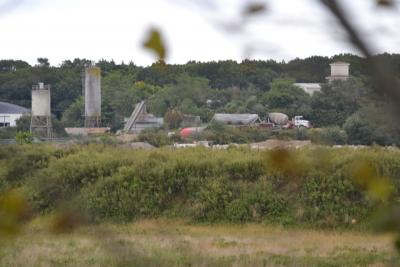Wainscott Study Focuses on Sand Pit

A public hearing on the Wainscott hamlet study drew praise and encouragement from residents at last Thursday’s meeting of the East Hampton Town Board, with some speakers emphasizing that the former sand pit property, north of Route 27 behind the business district and running all the way to the railroad tracks, represents an opportunity to alleviate the town’s critical shortage of affordable housing.
Wainscott lacks “pedestrian connectivity,” where people can easily walk from one place to another, and outdoor public spaces as well, the study has suggested, and the haphazard development of its commercial district has brought a strip-mall look and feel, with many curb cuts and uncoordinated parking lots. Along with mixed-use development and work-force housing at the former sand pit property, suggested changes include a roundabout to replace the traffic light at the intersection of Main Street and Wainscott Northwest Road; a consolidation of existing parking lots and vacant parcels into a cohesive parking area in the commercial district; parking lots designed with rain gardens and vegetated swales to filter stormwater; parallel on-street parking, continuous sidewalks, and new street trees in the business district, and, possibly, the installation of a decentralized community wastewater system or innovative alternative systems.
Water quality, and specifically wastewater treatment, is paramount among many Wainscott residents’ concerns. Sara Davison, executive director of the Friends of Georgica Pond Foundation, said that land acquisition and water quality are critical to the hamlet’s natural features and commercial development. She urged acquisition of the 70-acre sand pit, which she said the hamlet study did not address with sufficient reach or specificity.
“Friends of Georgica Pond encourages the board to think boldly about this once-in-a-lifetime opportunity to shape the future of Wainscott,” Ms. Davison said. Most of that land should be designated for municipal, recreational, and open space purposes, she said, given Wainscott “is already grappling with the legacy of past industrial activity,” along with “the worst traffic in the entire town.”
Kathryn Szoka of Sag Harbor, who is co-chairwoman of Progressive East End Reformers, agreed, calling acquisition of the sand pit property “an opportunity to house the probably 2,000 units of affordable housing that we need in the town right now.”
Ms. Davison also urged the purchase of the restaurant building on Montauk Highway at the north end of Georgica Pond, which this year housed Il Mulino. “This land is currently the only pre-existing, nonconforming, commercially used lot on the pond,” she said. “We thank the board for including this purchase in the plan recommendation already, but want to underscore what a relevant purchase this would be to the overall plan.” The land could be restored, removing a source of nitrogen contamination to Georgica Pond, she said.
Philip Young, an owner of the Wainscott Village commercial center, noted that Montauk Highway would have to be widened to accommodate parallel parking in order to address the lack of on-street parking common to other hamlets’ commercial districts. Municipal parking lots would also have to be created at a central location in the business district. But, he said, “the current owners of the Wainscott business properties are very concerned . . . about losing property rights such as sharing of their parking areas with other stores, losing current curb cuts, and also losing significant business due to a customer’s inability to park close to their stores.”
But Jose Arandia described “a misunderstanding of what this long-term proposal does.” Concern among business owners about losing parking spaces or reclassification of land is misplaced, he said. The hamlet study “is simply a long-term vision plan, and it could very well be a phase-by-phase-by-phase approach.” But the first phase, he said, should include acquisition of the sand pit.
“This isn’t going to happen tomorrow,” said Rick Del Mastro. Citing a future of driverless vehicles, he said that traffic, for example, may look very different than it does today. “What we’re establishing today is not set in stone,” he said. “It’s open to change, because there will be change.”
Indeed, the plan is flexible, Supervisor Peter Van Scoyoc said. “It’s more of a vision for the future.” Once adopted into the comprehensive plan, “future development and redevelopment will be considered through that lens.”
The hamlet studies began in 2015, with public input beginning the following year. The consultants, Peter Flinker of Dodson and Flinker, a Massachusetts consulting firm, and Lisa Liquori of Fine Arts and Sciences, a former town planning director, have presented updates since then, based on public comment from individuals, the hamlets’ citizens advisory committees, and chambers of commerce. The goal is to adopt recommendations for each hamlet to be incorporated into the town’s comprehensive plan.
The hearing on Wainscott was the first of several upcoming hearings; the second happens next Thursday with the East Hampton study. Amagansett will be considered on Nov. 1, followed by Springs on Nov. 15. Lastly, Montauk’s hamlet study will be the subject of a public hearing on Dec. 6.
All the hearings will be held at Town Hall, during town board meetings that start at 6:30 p.m. While an individual hamlet will be the focus of each hearing, comment on any hamlet will be accepted at all of them.
